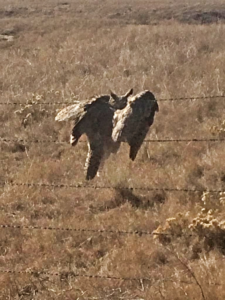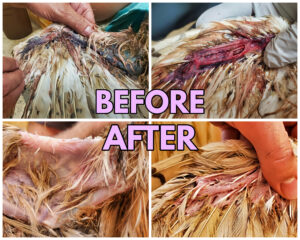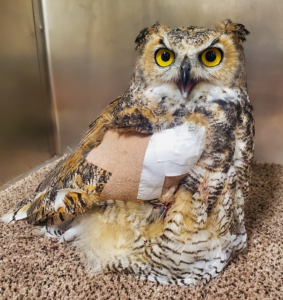The first words a raptor hears when it enters RMRP:
“Please, don’t give up! We’re here to help.”
We know they can’t understand us. But we wonder…
This battered Great Horned Owl embodies the phrase “long-shot.” He suffered severe injuries from being ensnared in a barbed wire fence. He was exhausted and could barely move, but he was ready to fight us at the rescue. As we carefully moved in to untangle him, he was in full attack mode, hissing and clacking his beak at us all the way.
How does such a mighty hunter, known for their amazing sight, come into such a predicament? What we know is that owls typically use their hearing, even more than their sight, while hunting at night. Thin, barely visible obstacles such as netting and barbed wire are a serious danger to them. In the wild he grasped life with his powerful talons and unrelenting spirit, but now it was time to stop fighting. We know he can’t understand that we’re there to help.
“Ensnarement” is #7 on our Top 10 list of most common injuries to raptors, and we see about 10 of this type of injury each year. We see it most with netting, fishing line, balloon strings, baling twine, or barbed wire; and sadly once the bird is caught, the desperation and repeated attempts to get free often cause grave damage to muscles, tendons, joints and feathers.
This Great Horned suffered some of the worst wounds from barbed wire punctures that we’ve seen in a treatable case. His right wing more closely resembled hamburger than a wing. There was exposed bone from shoulder to wrist, extreme bruising, internal trauma, and worst of all: damage to a very important flight tendon.
The Patagial tendon stretches from shoulder to wrist on a wing. Without a working patagium, a raptor cannot fly. This owl’s life depends on the healing of this tendon, but we have hope.
We have hope because of science. A relatively new treatment uses laser light to stimulate the building blocks of collagen, which is important in the wound healing of damaged tissues. Collagen is the essential protein required to replace old tissue or to repair injuries. As a result, the laser is effective on open wounds and burns.
His life is worth the effort.
This is where you come in. Can we count on you to give this owl a second chance at freedom?
Every single day, this owl receives $158 in care and procedures:
• Laser light therapy by CSU vets: $75
• Medications and fluid therapy for hydration: $50
• A mummy’s worth of bandaging and wound care: $25
• Nutritious diet of rats and mice: $8
That’s more than $1000 every week.
This long-shot, this fierce and determined Great Horned Owl’s healing journey continues today. He’s gaining strength in our large flight enclosures, but he’s facing a tough rehab. We’ll probably keep him for most of the winter and only release him when he proves he can hunt on his own again.
If any owl can overcome the odds, it’s this long-shot!
We hope you’ll consider a gift to help this long-shot touch the skies again. Your most generous gift will restore this fighter to health, and support our conservation programs and our lifesaving research.
We thank you for your dedication and commitment to our programs, and will keep you up-to-date with this fighter’s progress.
With greatest gratitude,
Carin Avila, Executive Director
Watch the owl fly for the first time since his injury!
It costs $158 a day to care for this owl. Will you help him continue to heal?



